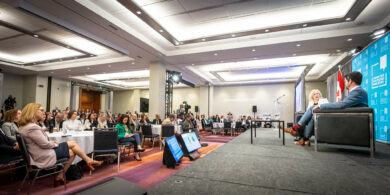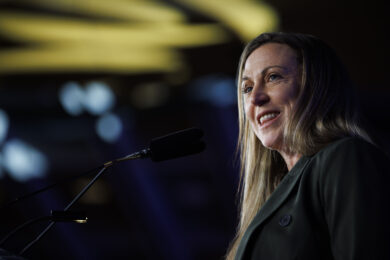
Discussion paper: Open policy making in a digital age
The concept of ‘open policy making’ represents a shift away from traditional policy making toward a process that is accessible and transparent to more Canadians, and which incorporates their voices and insights. How is this different in the digital age?
To download a printable .PDF version of this report, click here.
Executive Summary
On Oct. 13, 2016, the Clerks and Cabinet Secretaries came together for their second policy innovation conference. The theme of the event was “open policy- making in the digital age.” A number of themes emerged during the keynote and panel presentations. The dominant themes are explored in this discussion paper. Rather than conclusions, each theme posits questions to guide the future work of the broader community devoted to the adoption of open policy making in Canada.
This paper is produced to complement the summary report, which provides an overview of the presentations delivered in Ottawa on October 13.
Opening the policy making process; open is not always digital
The traditional policy- making process has been conducted largely behind closed doors. Data are collected and curated by government[1] departments, and analyzed to inform conversations between political elites who in turn make a decision that seeks to serve the public good. From these policies, programs and regulatory guidelines are developed, implemented and enforced. Policy evaluation is ongoing, including the electoral process, whereby citizens can indicate their level of satisfaction with the current government by casting their vote for a suite of policy promises.
A critical element of the traditional policy- making process is that it is largely the purview of professional policymakers: This is at the core of the idea of representative democracy. The concept of ‘open policy making’ represents a shift away from traditional policy- making, towards a process that is accessible and transparent to more Canadians, and which incorporates their voices and insights. Proponents of participatory governance cite a number of benefits of open models: opportunities for citizens to learn about policy and governance, legitimacy for public decisions, and ultimately, better, more inclusive public policy.
Open policy and digital tools are not mutually exclusive, but they can be complementary. By leveraging online, digital tools, policymakers can engage a wider audience, more often, and in multiple stages of the policy process. This can include:
- Identifying and/or defining a problem or challenge;
- Defining the primary and secondary target audiences affected by the problem/challenge;
- Engaging new voices in policy discussions;
- Making data sets open and accessible to the public for analysis and discussion;
- Running small-scale pilot solutions;
- Engaging third parties to jointly offer solutions/service delivery; and
- Broadening the scope and reach of policy evaluation.
In embracing an open policy- making process, governments transition from “policymakers” to “platforms[2] for policy- making”. The metaphor of the government as a platform is rooted in the digital environment. For example, companies like Apple or Samsung produce tools — phones, tablets — that run on operating systems designed to have third-party organizations build applications on top of them. Users can provide feedback directly to the producers as well as develop applications and upload them for the use of other users. This model offers two roles for government: one as accepting feedback from citizens (users) and integrating that feedback in the form of real-time change to policies and programs. The second model involves government opening aspects of its policy making suite of tools and engaging civil society in those individual stages. Understanding this, how/when/can/should government engage in open policy- making to approach wicked problems under its purview? When does the digital environment fundamentally change how public policy is created and when does it simply transition functions to a new interface? Recognizing that digital and open policy are not always synonymous, there is nonetheless an opportunity to identify and leverage digital tools that amplify the government’s role as a platform. What are those tools? How should they be applied? How will this new model of policy- making change the skillset public servants require to do their job? Each of these questions requires careful deliberation and discussion. The following discussion paper is meant to encourage readers to start thinking about each of these components of open policy- making in a digital age, recognizing that much more thought and work is ahead.
Effective partnerships and tools
“Government is better when it is actively enabling others — such as citizens and civil society — to bring their assets to the table. To solve public problems and create value.” These opening words by James Anderson of Bloomberg Philanthropy were followed by examples that demonstrated different types of partnerships and how they led to more effective results for both governments and the people whom they serve. A common thread between each of these examples is the recognition that in order to improve operations, they needed to learn, change their perspective and to look for help in new and even unlikely places. For example, a London-based hospital that wanted to improve its success rate of transitioning infants from surgery to the intensive care unit looked to a Formula 1 racing team for counsel and advice on high-pressure transfers. The mechanics of that Formula 1 team had logged considerable hours ‘in the pit’ working under intense pressure and with considerable time constraints to perform vehicle maintenance. The partnership between the hospital and the Formula 1 team enabled the hospital to improve their handoff rate by half. That hospital is now sending more children home to their parents, faster.
The same principle can be applied to policy making inside government: while each department or agency will contain areas of expertise on certain topics or processes, no one department or agency is the definitive expert on all aspects of policy making and implementation. It is therefore incumbent upon the department in question to determine where its strengths and weaknesses lie, and how to engage external expertise. There is no shortage of means to address a problem. This paper starts with two: partnerships and digital tools.
Effective partnerships
Increasingly, private sector and non-profit actors are raising their hands to tackle public challenges once considered the exclusive responsibility of governments.
Social enterprises are a growing reality in many Canadian and international jurisdictions, as evidenced by the presentations given by the HCT group, CASA Ltd. and Embers. These three social enterprises presented their business models in the form of case studies. Two began as partnerships with their local governments and slowly became independent organizations that supplement the work of the local government through a sustainable business model that provides high- quality jobs in the local economy and affordable, effective alternatives for residents with special transportation and health care needs. The third case study illustrated an example in which a Vancouver social enterprise launched a community-centric approach to alleviating unemployment, and subsequently became an alternative to the services provided by local government. All three businesses were created to fill gaps in public service delivery, and subsequently scaled up to become effective models of that same service delivery. These examples suggest that partnerships can also be created when an external party identifies a gap; partnerships will not always be initiated by government.
Not all partnerships will be effective. Julian LeGrand[3] argues that partnerships between government and a private sector or third sector partner must be carefully constructed to account for and address the different motivations that fuel each sector. Doing so will ensure that the private citizen remains the beneficiary of the partnership. LeGrand has labelled this approach policy- making for ‘knights and knaves’. Building an effective partnership with clear goals in mind will involve recognizing and managing those incentives such that each partner is rewarded according to their incentive structure. What types of policy challenges can be effectively addressed through partnerships? What indicators should be used to determine the right partnership model for a given challenge? When governments are actively supporting civil society organizations in addressing social challenges, how are accountability, safety, liability and impact ensured? Are current procurement and granting structures sufficient to maximally leverage the capacity and expertise outside of government? Drawing from LeGrand’s work, how can the architects of a partnership ensure the reward feeds all motivations? And, that metrics of a policy or program focus on outcomes and not outputs?
Digital tools
New digital tools — often from companies that have become global powerhouses — present tremendous potential for governments to engage Canadians in different stages of the policy process, and to collect more and broader opinions and information on an issue at hand. The use of these tools also requires tremendous consideration and careful navigation.
Digital tools provide opportunities:
- Digital tools meet Canadians at work, home and play. They enable government to conduct consultations across Canada that scale easily to additional participants.
- If designed appropriately, digital tools can engage a broad mix of Canadians: different ages, genders, educational attainment, in rural, suburban and urban environments, different ethnic backgrounds and more.
- Digital tools create vast amounts of data about how people use government services, search for information and navigate their lives.
The use of digital tools also requires careful consideration. Speakers that discussed the use of digital tools encouraged government to consider the following:
- Engage with Canadians on the platforms that they are already using. Don’t create new tools or attempt to drive conversation to different platforms.
- Engaging Canadians by digital means can exclude citizens across cultural, geographic, demographic, educational and other divides.
- Don’t fall prey to “build it and they will come” thinking: engaging Canadians on a digital platform still requires governance to identify the goal, spell out expectations and timelines, be responsible for and responsive to information shared through that platform and deliver on promises.
- Recognize that the immediacy of social media and digital tools can be at odds with the context of the greater policy development machine that is slow- moving.
As with partnerships, the decision to use a digital tool to advance policy discussion or development in any area should add strategic value. What types of policy challenges can be effectively addressed through the use of an online tool? What audience will be engaged through the use of a digital tool? What voices and information need to be heard to make sound public policy decisions? What conversations do stakeholders need to have? How must we design citizen engagement to account for multiple, and possibly, competing goals? What are the limitations, and when should governments stick with IRL (in real life) approaches?
Learn to ‘read’ the voices
Participants in a face-to-face consultation bring biases to the table, which facilitators are trained to identify. Facilitators also have the added support of information about each participant, possibly including their name and occupation. Participants in an online consultation also bring their biases ‘to the table,’ but the markers of their bias may not be so obvious.
Learning to identify the biases of online participants is more than just creating requirements for participants to share biographical data. It is also important to understand the means by which online networks are created, how they attract and circulate information, and by design, how participants will (be) engage(d) in an online policy discussion. Two speakers spoke at length about digital tools; each digital tool operates according to a series of algorithms. These algorithms present biases that determine what type of information a person will receive based on the preferences they express through their online activity. Over a period of time, these algorithms create ‘filter bubbles’ that furnish the user with information to which they will be receptive. For example, someone actively expressing a certain view will increasingly see that viewpoint in their online media. Most important: many users are unaware that they are operating in a filter bubble. For the government, this polarization is a concern for citizen engagement specifically, and a digital citizenry in general. What skills do policymakers require to identify when their engagement activity has been absorbed by a single type of bubble? How must we design citizen engagement activities to ‘break into’ varied and diverse types of filter bubbles? How can policymakers ensure that they engage the diversity of voices necessary to capture all viewpoints on an issue?
A (case for a) new skill set
Learning to read and understand the voices, as touched upon above, is one of the many new skills that government employees will require in the broader move towards a government that employs open and digital policy- making tools.
During the Clerks and Cabinet Secretaries lunch session, Lena Trudeau, having worked with the U.S. government prior to joining Amazon, highlighted the imperative for a rethink of public service competencies. In the U.S. case, the President himself has closed the deal for top technology talent, as part of a push to create centres of expertise to lead the wider public service towards a more digitally savvy, open, collaborative government. In the U.K., the Department of Work and Pensions has started rotating program and policy staff through six-week digital bootcamps as well; their leadership has deemed digital literacy to be vital for staff beyond those in specifically tech-focused roles.
But what constitutes “technology talent” or “digital literacy”? These terms can only be a rough signpost for governments. What’s the balance of in-house and external skills and competencies? Identifying and defining the new skill set — and assessing against the current state — is a prerequisite for understanding needs around training, recruitment and options for procurement and partnerships. The same is true for the world of citizen engagement and open policy- making: it’s a unique field (particularly when ported to the digital world) that spans policy, logistics, communications, usability and social science.
These skills are needed now. Several speakers observed the ongoing federal processes to consult Canadians. There are an estimated 200 consultations under way at present (November 2016). Yet the format for each consultation — from who is engaged, to how they are engaged, to the goals of the consultation and next steps — vary from consultation to consultation across 98 departments and agencies. The variations in approach to each consultation will generate results that are not comparable, making it harder to learn lessons and systematically improve.
In addition to the long- term value of the information collected, the current series of consultations raise questions about public governance in these new (digital) spaces, and managing expectations of citizens. Digitally engaged citizens have an expectation of providing feedback — to their grocery stores, their automotive dealerships and the companies that produce their smart phones and apps — and witnessing the real-time integration of that feedback. These responsive organizations have created a culture of expectation for Canadians, and if citizens have an unsatisfying experience with government engagement processes, this has an impact on trust: they’ll likely sit out in the future. What is the current government-to-citizen interface? How are citizen expectations and relationships being governed and managed through these consultations? What steps can/should government take — in the midst of ongoing consultations — to avoid further damaging public confidence in the public policy process? How can early successes be scaled across the whole of government?
The R word
There is an asymmetrical risk-reward system inside government. As noted on Oct. 13, the government hierarchy — as a collective — rewards those who take little or no risk. Similarly, openness — within or from government to external environments — carries few rewards for individual actors within government, and creates significant individual risk. But in a world of increasing transparency, citizens have different expectations of their government. The lack of evident change or movement on issues of national importance in recent years has led to a crisis in public confidence in Canada, exacerbated by the expectation of immediacy described above. Yet Canada’s crisis of public confidence was not born of an emergency situation that prompted quick decision. It is the product of a slow, steady, persistent degradation where the moment of urgency is difficult to distinguish and may have passed us, or may appear when it is too late to act. Is public confidence a disruptive threat facing government? Is open policy making a solution to rebuilding public confidence? Will the early foray into open policy making change the face of government in one, five or 10 years? Should it?
Next steps
Throughout 2016 and 2017, Canada’s Public Policy Forum will be working with partners and members to better understand digital-era governance: exploring the challenges, opportunities and cultures of the digital era, and distinguishing between what’s simply “changing the channel” to digital, and what’s fundamentally different for governments and stakeholders. The goal will be a roadmap for substantial progress on digital governance at, and between, multiple orders of government in Canada.
The Forum’s project will be structured around five themes:
Digital government: culture, talent, digital services and platforms, procurement, digitally-enabled policy, data-driven government, inter-jurisdictional collaboration;
Open government: transparency, accountability, open data, public engagement, open policy- making;
Civic and private-sector change and capacity: external capacity for public organization, action and innovation, for better or worse;
Analogue institutions in the digital area: organizations, policies, regulations, legislation; public sector accountability, values and anonymity in a hyper-networked world; and
Digitally driven or enabled trends on society and economy: industry disruption, precarious employment, communication trends, education, public discourse.
This will include many of the questions presented at the Clerks and Cabinet Secretaries meeting: and within them, there are common recurring threads such as digital skill sets, the impact of social media on discourse and decision-making, fairness and inclusivity and risk:
- Digital disruptions to jobs and the economy;
- The idea of government as a platform for civic technology, social good corporations and social innovation;
- Regulating technologies and industries that emerge and shift quickly;
- Social changes like shifting media landscapes and different voices appearing in the public policy sphere;
- Digital moving “upstream” from a delivery and transparency model to a core consideration at the policy genesis stage; and
- Inventorying the skills required for mass collaboration, open policy making and a digital governance landscape — and comparing against the current state.
The Public Policy Forum will explore those themes and questions, and develop recommendations for positive progress through events, case studies and interviews with experts and practitioners. This will be synthesized into a final set of reporting in fall 2017 to share with partners and members.
Endnotes
[1] The term ‘government’ is used throughout this paper as a broad, inclusive term to identify any public institution, department, office or agency at the federal, provincial, territorial and municipal level in Canada
[2] Tim O’Reilly (2011). “Government as a platform”, Innovations: Technology, Governance & Globalization, 6(1), p. 13–40. Available online: http://www.mitpressjournals.org/doi/abs/10.1162/INOV_a_00056#.WFhlJPkrKUk
[3] LeGrand J. (1997) Knights, Knaves or Pawns? Human Behaviour and Social Policy, Journal of Social Policy, 26 (2) 146–169





